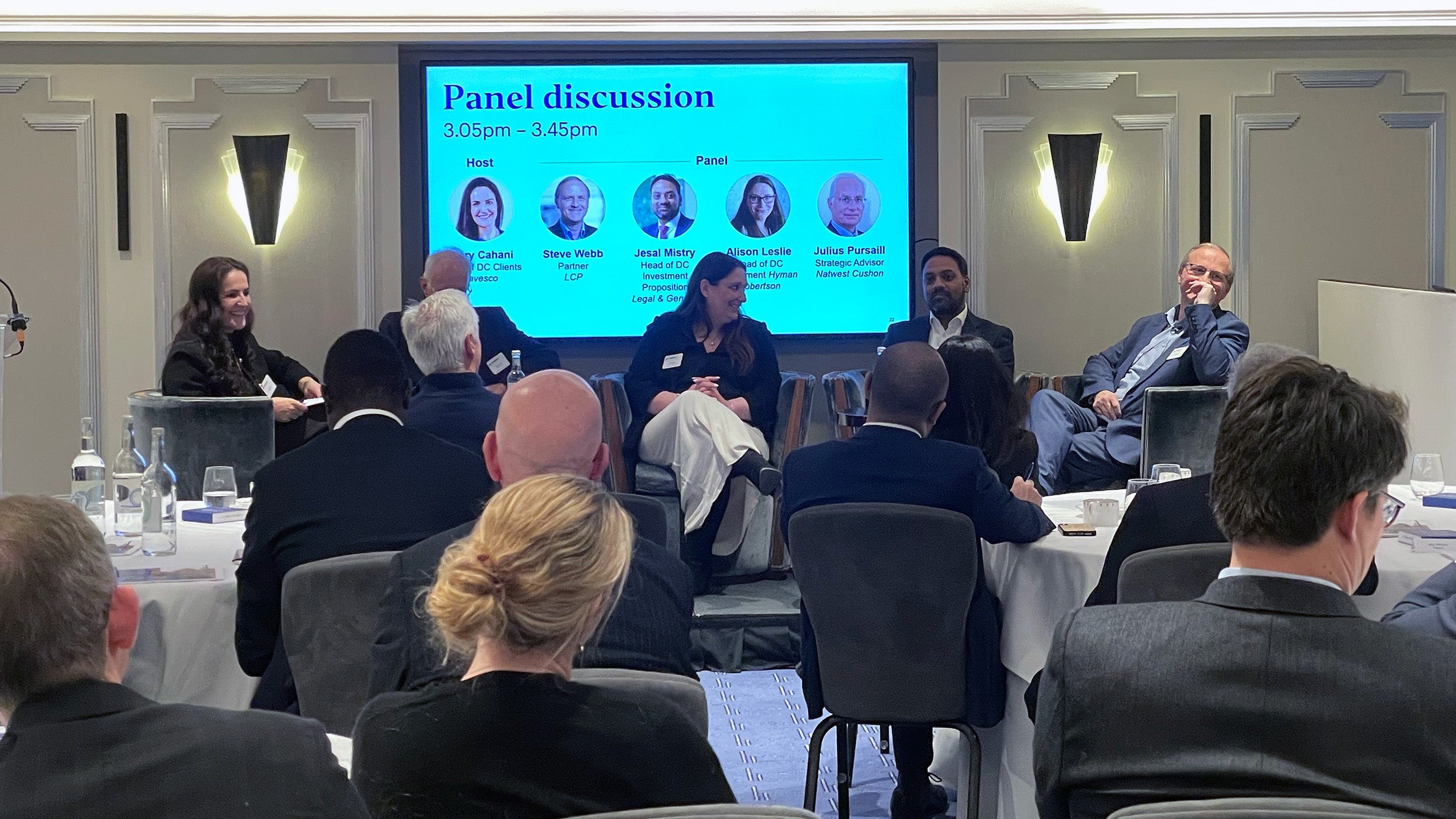
Will high tariffs push the US into recession?
As a trade war rages, a massive market sell-off in the US and around the world raises many questions for investors.

UK regulations encourage DC assets to be invested domestically in private equity, local impact projects and infrastructure.
There are plans for DC pension funds to be subject to a traffic light system as part of the VfM framework.
Collaboration and working together is necessary to get the best outcomes from UK regulatory change.
Over the past 10 years, the industry has got together for Invesco’s Defined Contribution (DC) Exchange to talk about the issues impacting them the most.
“It’s something we started 10 years ago as a Chatham House rules event for DC schemes to share best ideas, and proud to say we have kept it up for 10 years,” said Sachin Bhatia, Head of UK Pensions and EMEA Consultant Relationships at Invesco. “And we have now broadened participation and invited consultants and advisors to join this discussion as the DC market enters its next exciting era."
For our DC Exchange 10th year anniversary event, the focus was what UK DC pensions will look like in the next 10 years in relation to regulation, consolidation, innovation and value for money.
Our keynote speaker Steve Webb, Partner at LCP & former UK Pension Minister, discussed the implications of government announcements in the UK Autumn Budget and Mansion House.
A panel discussion then looked at how the latest changes will impact the industry. Hosted by Mary Cahani, Head of DC Clients at Invesco, the panel featured Webb, alongside, Alison Leslie, Head of DC Investment at Hymans Robertson, Jesal Mistry, Head of DC Investment Proposition at Legal & General and Julius Pursaill, Strategic Advisor at NatWest Cushon.
Read our takeaways of the highlights from the event.
Thanks to all our attendees for their lively participation in our ten-year anniversary event!
The big announcement in the UK budget for pensions was it would be now subject to IHT (inheritance tax) from April 2027. The details still need to be worked out, but it could be an administrative nightmare for DC schemes and bereaved families.
The bereaved family will have to find out all the pensions of which they were a member and get a valuation. If it's a DC scheme it’s likely the valuation will need to be as at the date of the members of death. “Good luck with that,” said Steve Webb, Partner at LCP & former UK Pension Minister.
An IHT figure, will be calculated from all the pension schemes and it will be worked out, what each scheme owes. Only after this is finalised, the family can apply for probate and start sorting out the estate, which probably could be a year or more away.
In the UK Autum Budget, the government increased National Insurance (NI) from 13.8% to 15% for April 2025 and lowered the threshold employers must start paying NI to £5,000 from £9,100.
Webb thought this would significantly impact employers that hire low paid workers and part-timers. It’s a double whammy for them as it’s the same group that will be hit by the ‘2017 Automatic Enrolment Review,’ originally due to be introduced in the mid-2020s but now apparently on hold. Here the government announced the age threshold for automatic enrolment would be lowered from 22 to 18 years and the 8% minimum contribution rate be applied to the first pound instead of £6,000.
Both policies are likely to significantly increase wage costs for employers and there’s concern that, having increased NI costs on employers, the Government may now be reluctant to take the vital next steps on automatic enrolment through asking more of employers.
Webb said: “The prospect of enough money going in DC pensions has just been kicked even further down the track.”
In the Mansion House speech, the government also announced plans to create pension ‘mega-funds’ by 2030.
The aim of these is for funds is to promote economic growth through domestic investment. In the Labour manifesto there was an emphasis to put more money into UK investments as there’s been a decline in funds investing in UK equities.
The government wants more investment in the UK through private equity and to boost the money going into infrastructure.
The government thinking behind this, Webb said, is: “if we can get pension schemes to invest more in unlisted equities and infrastructure, we get a kind of growth dividend. We boost the UK economy without having to tell anybody to invest in the UK, because of the greater ‘home bias’ in these assets.
“Investing in the UK generates growth, generates tax, generates money for the NHS, generates hip operations, and generates votes.”
In July 2024, the government launched the National Wealth Fund (NWF) to support private investment in growth industries. The previous government introduced LTAFs in November 2021 to facilitate long-term investments in less liquid markets.
The minimum size for the ‘mega funds’ will be £25 billion plus. But there are many good schemes under this size. These will either need to be consolidated or wound up as a result.
The 'mega funds' proposals continue to be a topic of much debate. Webb pointed out there is lots of concern about the consolidation process and whether these funds will become too big to fail.
Webb thought the proposed traffic light system in the Value for Money (VfM) framework, will start weeding out some of the smaller players.
He is worried some funds that could produce good returns over a long-term may be forced to close. In the proposed system if a fund gets a red rating they have to shut down, amber means returns will need to improve in a year or they could be shut down, and green means carry on.
Webb pointed out having an amber rating makes it very difficult for employers to stay with you. Schemes may be reluctant to take longer-term risks if the return is not there after 12 months. For example, investing in an area such as illiquids that have a longer return timeframe.
“There’s a risk here of homogenisation, lack of innovation and herding,” said Webb.
The panel hosted by Mary Cahani, Head of DC Clients at Invesco, gave an insight into how these changes will play out in the next 10 years.
“We have been exchanging ideas for over 10 years in DC and there’s still a lot more work to do over the next 10 years,” said Cahani.
In the next decade, there’s a lot of change ahead for the DC pension industry. The industry will need to deal with new regulations, consolidation, innovation and how to best provide members with the best value for money. Each will have their own set of challenges.
Collaboration will be key between the industry and government to deal with the changes.
“I think our voice would be louder and better if we all actually worked in concert,” said Alison Leslie, Head of DC Investment at Hymans Robertson. So, what I'd like to see is the ask for the future is a little bit more about collaboration and pulling together.”
What Jesal Mistry, Head of DC Investment Proposition at Legal & General, is finding challenging is the discussion around potentially mandating exposures to UK assets.
“There's a lot of opportunity in the UK to generate very good returns, lots of demands and need for investment,” said Mistry. “There’s a focus around best interest for members, but the focus on making it policy, I’m very sceptical about it. We shouldn’t just be focused on the UK. We don’t have to be.
“They are looking at the Australian market in particular, maybe the Canadian. They are looking at those schemes and a lot of them have lots of private market exposure, a lot of that is home bias. But there's a global element to it as well, for example, Australian pension funds are over here buying the Manchester Airport Group.”
However, Julius Pursaill, Strategic Advisor at NatWest Cushon believed pension funds should be overweight UK as it’s part of the member’s financial interest.
“The standard of social care, healthcare, education, access to green spaces all those affect our members standard of living in retirement,” said Pursaill.
“Why is it that we don't take that into account? We don't take this into account because the guidance that sits around fiduciary duty tells us we need to focus on financial factors.
“Fine! But I have suggested that they are financial factors. The guidance says financial factors as they apply to the size of the fund or the income that fund produces, not what you can buy with the income. We need to focus on the quality of society in which our members are going to retire.”
There was a lot of talk about pension schemes from a value for money perspective and the red, amber, and green ratings.
“Why would you bother if you're going to end up amber or red,” said Mistry. “Even if it's in the interests of members, you only have one year to deliver the returns that puts you in the green mode. That for me is a fundamental problem there's no incentive to do anything more than what everyone else is doing. We could ultimately end up in a herding situation.”
Pursaill agreed and said: “You can’t just have past performance, it’s just very destructive in terms of long-term value creation.”
Another big topic was whether the ‘mega funds’ proposal would stifle innovation.
“If you get some of these smaller Master Trusts that have been disruptors and innovators in the market and they are moved out, I think that's quite dangerous,” said Leslie. “Sometimes the bigger you get it's very difficult to move.”
Although Leslie pointed out there were efficiencies to be gained by being big, she believed it’s vital to have small players that can innovative and challenge the industry.
Mistry thought the government were primarily focused on investment innovation. “They want to be able to leverage the scale of the UK pensions industry to be able to support UK projects and growth and are looking in envy towards other countries where home bias is greater,” he said. “It’s our responsibility to make sure that we are able to deliver on the potential upsides of this increased investment, all within the context of continuing to focus on delivering good outcomes for members.”
Webb was worried that being so big might not create a level playing field. “How do you regulate schemes when some of these are going to be quarter of a trillion?” said Webb. “It's not an even playing field. There’re competition laws that try to prevent massive oligopolies of this sort and that's what we're creating by design.”
Over the next 10 years the DC pension market will continue to evolve as the industry adapts to change. “Collaboration will be necessary for the industry to address the challenges that lie ahead,” concluded Cahani. “Regulation is happening at speed. Companies will need to work together, consolidate and innovate to meet the changing needs.”

As a trade war rages, a massive market sell-off in the US and around the world raises many questions for investors.

In our monthly market roundup for February, Invesco experts give a rundown of a mixed month for global equity markets, as well as an update on fixed income markets.

With policy uncertainty rattling markets and consumer sentiment, it’s important to remember the market's long-term growth throughout its history.


Sign up to receive the latest insights from Invesco’s global team of experts and details about on demand and upcoming online events.
The value of investments and any income will fluctuate (this may partly be the result of exchange rate fluctuations) and investors may not get back the full amount invested.
Data as at 16th January 2025.
This is marketing material and not financial advice. It is not intended as a recommendation to buy or sell any particular asset class, security or strategy. Regulatory requirements that require impartiality of investment/investment strategy recommendations are therefore not applicable nor are any prohibitions to trade before publication.
Views and opinions are based on current market conditions and are subject to change.
EMEA4164434